Claymore Consultants: Organising for Survival - Case Study Analysis
VerifiedAdded on 2022/11/07
|12
|3783
|362
Case Study
AI Summary
This case study examines Claymore Consultants, a management consulting firm facing significant challenges in its organisational structure and market position. The analysis identifies key issues, including poor communication, strained employee relationships, and high employee turnover, which have led to a decline in the company's performance. The paper proposes a change management strategy, highlighting nine crucial change indicators such as diversity acceptance, fair treatment of employees, and strong leadership. It applies Lewin's Change Management Model (Unfreeze, Change, Refreeze) to outline steps for organisational transformation, including the need for revised leadership, improved communication, and investment in employee training and development. The study emphasizes the importance of addressing employee concerns, fostering a positive work environment, and implementing strategies for competitive advantage, aiming to revitalize Claymore Consultants and ensure its long-term survival and growth in the market.
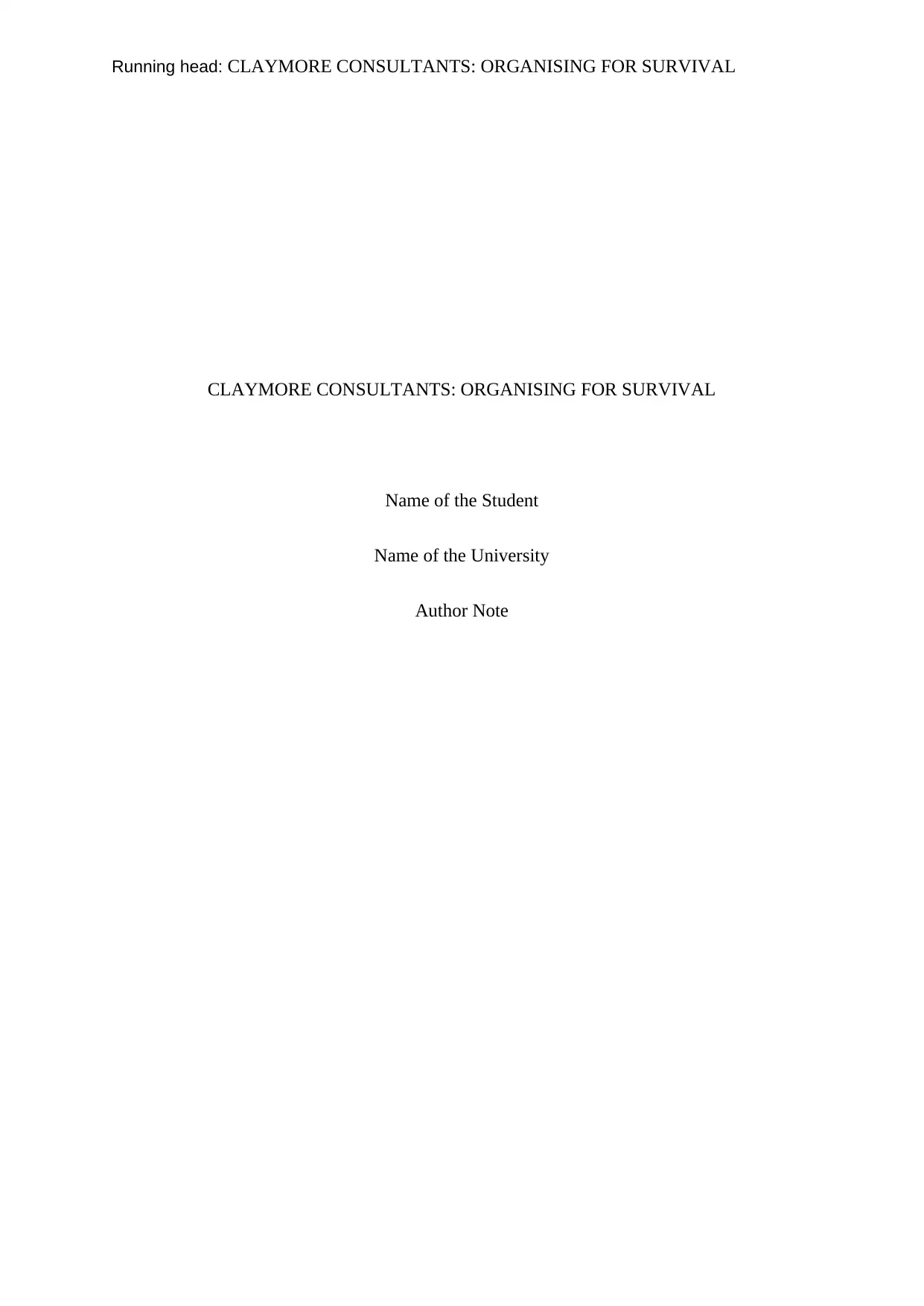
Running head: CLAYMORE CONSULTANTS: ORGANISING FOR SURVIVAL
CLAYMORE CONSULTANTS: ORGANISING FOR SURVIVAL
Name of the Student
Name of the University
Author Note
CLAYMORE CONSULTANTS: ORGANISING FOR SURVIVAL
Name of the Student
Name of the University
Author Note
Paraphrase This Document
Need a fresh take? Get an instant paraphrase of this document with our AI Paraphraser
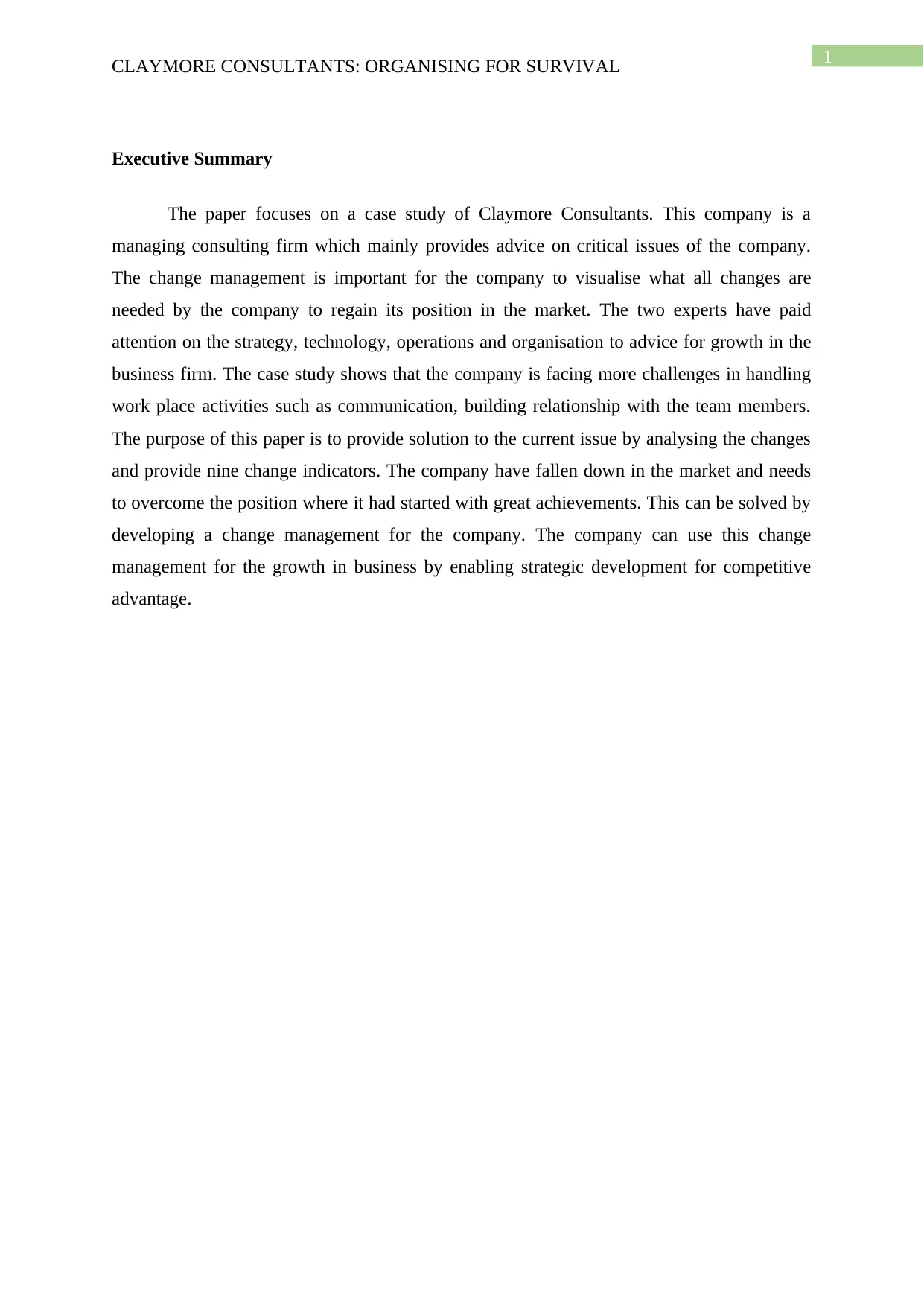
1
CLAYMORE CONSULTANTS: ORGANISING FOR SURVIVAL
Executive Summary
The paper focuses on a case study of Claymore Consultants. This company is a
managing consulting firm which mainly provides advice on critical issues of the company.
The change management is important for the company to visualise what all changes are
needed by the company to regain its position in the market. The two experts have paid
attention on the strategy, technology, operations and organisation to advice for growth in the
business firm. The case study shows that the company is facing more challenges in handling
work place activities such as communication, building relationship with the team members.
The purpose of this paper is to provide solution to the current issue by analysing the changes
and provide nine change indicators. The company have fallen down in the market and needs
to overcome the position where it had started with great achievements. This can be solved by
developing a change management for the company. The company can use this change
management for the growth in business by enabling strategic development for competitive
advantage.
CLAYMORE CONSULTANTS: ORGANISING FOR SURVIVAL
Executive Summary
The paper focuses on a case study of Claymore Consultants. This company is a
managing consulting firm which mainly provides advice on critical issues of the company.
The change management is important for the company to visualise what all changes are
needed by the company to regain its position in the market. The two experts have paid
attention on the strategy, technology, operations and organisation to advice for growth in the
business firm. The case study shows that the company is facing more challenges in handling
work place activities such as communication, building relationship with the team members.
The purpose of this paper is to provide solution to the current issue by analysing the changes
and provide nine change indicators. The company have fallen down in the market and needs
to overcome the position where it had started with great achievements. This can be solved by
developing a change management for the company. The company can use this change
management for the growth in business by enabling strategic development for competitive
advantage.
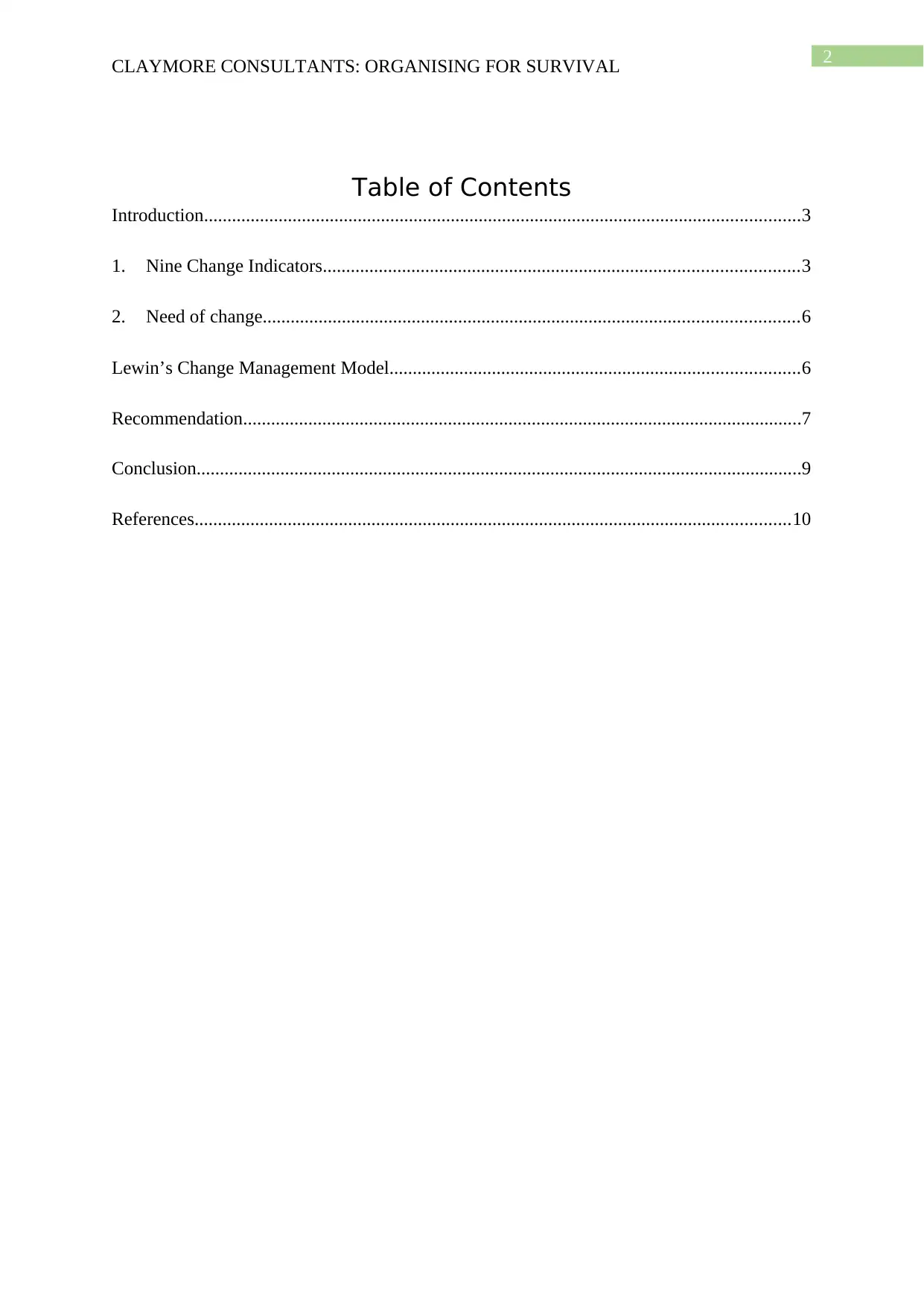
2
CLAYMORE CONSULTANTS: ORGANISING FOR SURVIVAL
Table of Contents
Introduction................................................................................................................................3
1. Nine Change Indicators......................................................................................................3
2. Need of change...................................................................................................................6
Lewin’s Change Management Model........................................................................................6
Recommendation........................................................................................................................7
Conclusion..................................................................................................................................9
References................................................................................................................................10
CLAYMORE CONSULTANTS: ORGANISING FOR SURVIVAL
Table of Contents
Introduction................................................................................................................................3
1. Nine Change Indicators......................................................................................................3
2. Need of change...................................................................................................................6
Lewin’s Change Management Model........................................................................................6
Recommendation........................................................................................................................7
Conclusion..................................................................................................................................9
References................................................................................................................................10
⊘ This is a preview!⊘
Do you want full access?
Subscribe today to unlock all pages.

Trusted by 1+ million students worldwide
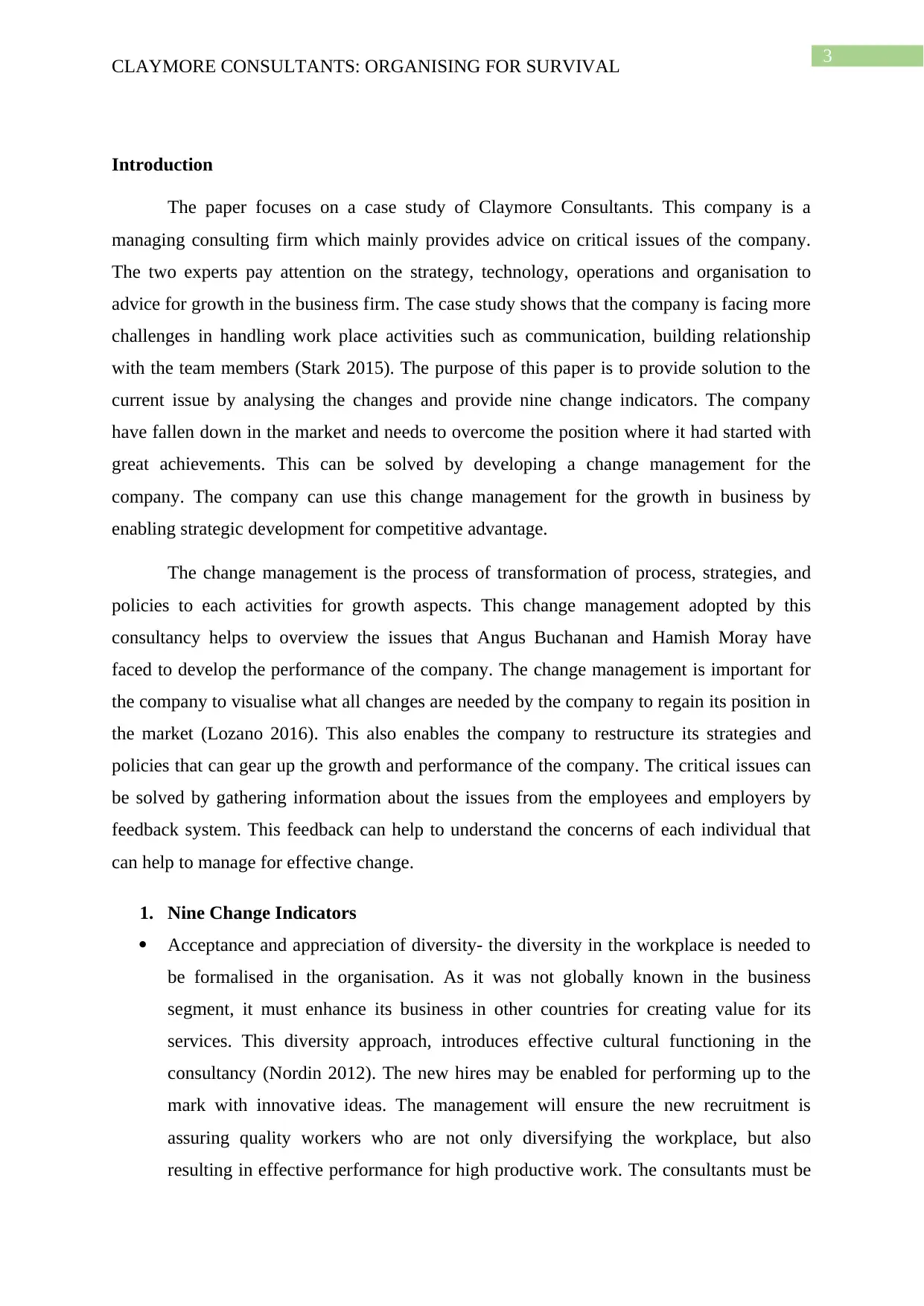
3
CLAYMORE CONSULTANTS: ORGANISING FOR SURVIVAL
Introduction
The paper focuses on a case study of Claymore Consultants. This company is a
managing consulting firm which mainly provides advice on critical issues of the company.
The two experts pay attention on the strategy, technology, operations and organisation to
advice for growth in the business firm. The case study shows that the company is facing more
challenges in handling work place activities such as communication, building relationship
with the team members (Stark 2015). The purpose of this paper is to provide solution to the
current issue by analysing the changes and provide nine change indicators. The company
have fallen down in the market and needs to overcome the position where it had started with
great achievements. This can be solved by developing a change management for the
company. The company can use this change management for the growth in business by
enabling strategic development for competitive advantage.
The change management is the process of transformation of process, strategies, and
policies to each activities for growth aspects. This change management adopted by this
consultancy helps to overview the issues that Angus Buchanan and Hamish Moray have
faced to develop the performance of the company. The change management is important for
the company to visualise what all changes are needed by the company to regain its position in
the market (Lozano 2016). This also enables the company to restructure its strategies and
policies that can gear up the growth and performance of the company. The critical issues can
be solved by gathering information about the issues from the employees and employers by
feedback system. This feedback can help to understand the concerns of each individual that
can help to manage for effective change.
1. Nine Change Indicators
Acceptance and appreciation of diversity- the diversity in the workplace is needed to
be formalised in the organisation. As it was not globally known in the business
segment, it must enhance its business in other countries for creating value for its
services. This diversity approach, introduces effective cultural functioning in the
consultancy (Nordin 2012). The new hires may be enabled for performing up to the
mark with innovative ideas. The management will ensure the new recruitment is
assuring quality workers who are not only diversifying the workplace, but also
resulting in effective performance for high productive work. The consultants must be
CLAYMORE CONSULTANTS: ORGANISING FOR SURVIVAL
Introduction
The paper focuses on a case study of Claymore Consultants. This company is a
managing consulting firm which mainly provides advice on critical issues of the company.
The two experts pay attention on the strategy, technology, operations and organisation to
advice for growth in the business firm. The case study shows that the company is facing more
challenges in handling work place activities such as communication, building relationship
with the team members (Stark 2015). The purpose of this paper is to provide solution to the
current issue by analysing the changes and provide nine change indicators. The company
have fallen down in the market and needs to overcome the position where it had started with
great achievements. This can be solved by developing a change management for the
company. The company can use this change management for the growth in business by
enabling strategic development for competitive advantage.
The change management is the process of transformation of process, strategies, and
policies to each activities for growth aspects. This change management adopted by this
consultancy helps to overview the issues that Angus Buchanan and Hamish Moray have
faced to develop the performance of the company. The change management is important for
the company to visualise what all changes are needed by the company to regain its position in
the market (Lozano 2016). This also enables the company to restructure its strategies and
policies that can gear up the growth and performance of the company. The critical issues can
be solved by gathering information about the issues from the employees and employers by
feedback system. This feedback can help to understand the concerns of each individual that
can help to manage for effective change.
1. Nine Change Indicators
Acceptance and appreciation of diversity- the diversity in the workplace is needed to
be formalised in the organisation. As it was not globally known in the business
segment, it must enhance its business in other countries for creating value for its
services. This diversity approach, introduces effective cultural functioning in the
consultancy (Nordin 2012). The new hires may be enabled for performing up to the
mark with innovative ideas. The management will ensure the new recruitment is
assuring quality workers who are not only diversifying the workplace, but also
resulting in effective performance for high productive work. The consultants must be
Paraphrase This Document
Need a fresh take? Get an instant paraphrase of this document with our AI Paraphraser
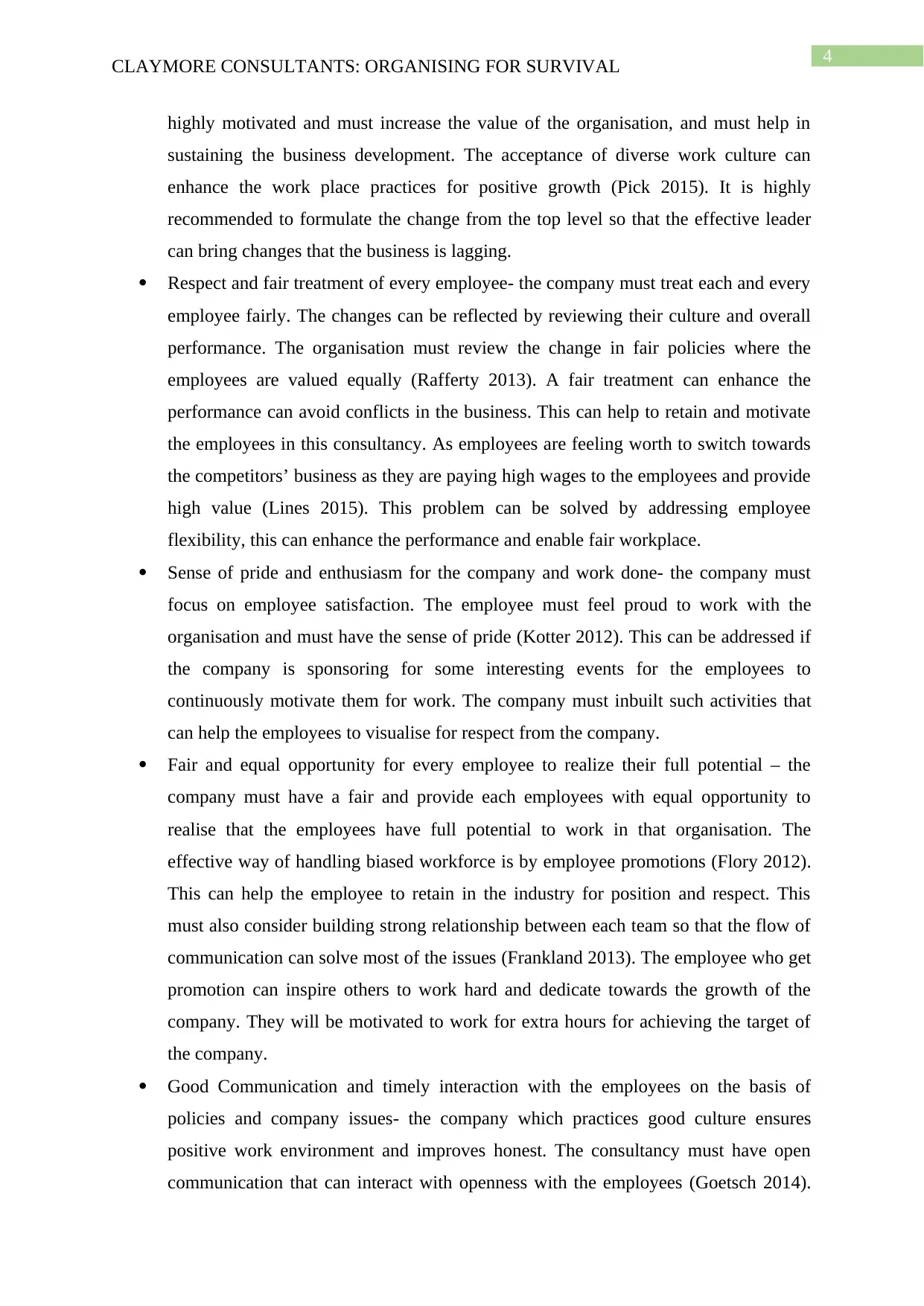
4
CLAYMORE CONSULTANTS: ORGANISING FOR SURVIVAL
highly motivated and must increase the value of the organisation, and must help in
sustaining the business development. The acceptance of diverse work culture can
enhance the work place practices for positive growth (Pick 2015). It is highly
recommended to formulate the change from the top level so that the effective leader
can bring changes that the business is lagging.
Respect and fair treatment of every employee- the company must treat each and every
employee fairly. The changes can be reflected by reviewing their culture and overall
performance. The organisation must review the change in fair policies where the
employees are valued equally (Rafferty 2013). A fair treatment can enhance the
performance can avoid conflicts in the business. This can help to retain and motivate
the employees in this consultancy. As employees are feeling worth to switch towards
the competitors’ business as they are paying high wages to the employees and provide
high value (Lines 2015). This problem can be solved by addressing employee
flexibility, this can enhance the performance and enable fair workplace.
Sense of pride and enthusiasm for the company and work done- the company must
focus on employee satisfaction. The employee must feel proud to work with the
organisation and must have the sense of pride (Kotter 2012). This can be addressed if
the company is sponsoring for some interesting events for the employees to
continuously motivate them for work. The company must inbuilt such activities that
can help the employees to visualise for respect from the company.
Fair and equal opportunity for every employee to realize their full potential – the
company must have a fair and provide each employees with equal opportunity to
realise that the employees have full potential to work in that organisation. The
effective way of handling biased workforce is by employee promotions (Flory 2012).
This can help the employee to retain in the industry for position and respect. This
must also consider building strong relationship between each team so that the flow of
communication can solve most of the issues (Frankland 2013). The employee who get
promotion can inspire others to work hard and dedicate towards the growth of the
company. They will be motivated to work for extra hours for achieving the target of
the company.
Good Communication and timely interaction with the employees on the basis of
policies and company issues- the company which practices good culture ensures
positive work environment and improves honest. The consultancy must have open
communication that can interact with openness with the employees (Goetsch 2014).
CLAYMORE CONSULTANTS: ORGANISING FOR SURVIVAL
highly motivated and must increase the value of the organisation, and must help in
sustaining the business development. The acceptance of diverse work culture can
enhance the work place practices for positive growth (Pick 2015). It is highly
recommended to formulate the change from the top level so that the effective leader
can bring changes that the business is lagging.
Respect and fair treatment of every employee- the company must treat each and every
employee fairly. The changes can be reflected by reviewing their culture and overall
performance. The organisation must review the change in fair policies where the
employees are valued equally (Rafferty 2013). A fair treatment can enhance the
performance can avoid conflicts in the business. This can help to retain and motivate
the employees in this consultancy. As employees are feeling worth to switch towards
the competitors’ business as they are paying high wages to the employees and provide
high value (Lines 2015). This problem can be solved by addressing employee
flexibility, this can enhance the performance and enable fair workplace.
Sense of pride and enthusiasm for the company and work done- the company must
focus on employee satisfaction. The employee must feel proud to work with the
organisation and must have the sense of pride (Kotter 2012). This can be addressed if
the company is sponsoring for some interesting events for the employees to
continuously motivate them for work. The company must inbuilt such activities that
can help the employees to visualise for respect from the company.
Fair and equal opportunity for every employee to realize their full potential – the
company must have a fair and provide each employees with equal opportunity to
realise that the employees have full potential to work in that organisation. The
effective way of handling biased workforce is by employee promotions (Flory 2012).
This can help the employee to retain in the industry for position and respect. This
must also consider building strong relationship between each team so that the flow of
communication can solve most of the issues (Frankland 2013). The employee who get
promotion can inspire others to work hard and dedicate towards the growth of the
company. They will be motivated to work for extra hours for achieving the target of
the company.
Good Communication and timely interaction with the employees on the basis of
policies and company issues- the company which practices good culture ensures
positive work environment and improves honest. The consultancy must have open
communication that can interact with openness with the employees (Goetsch 2014).
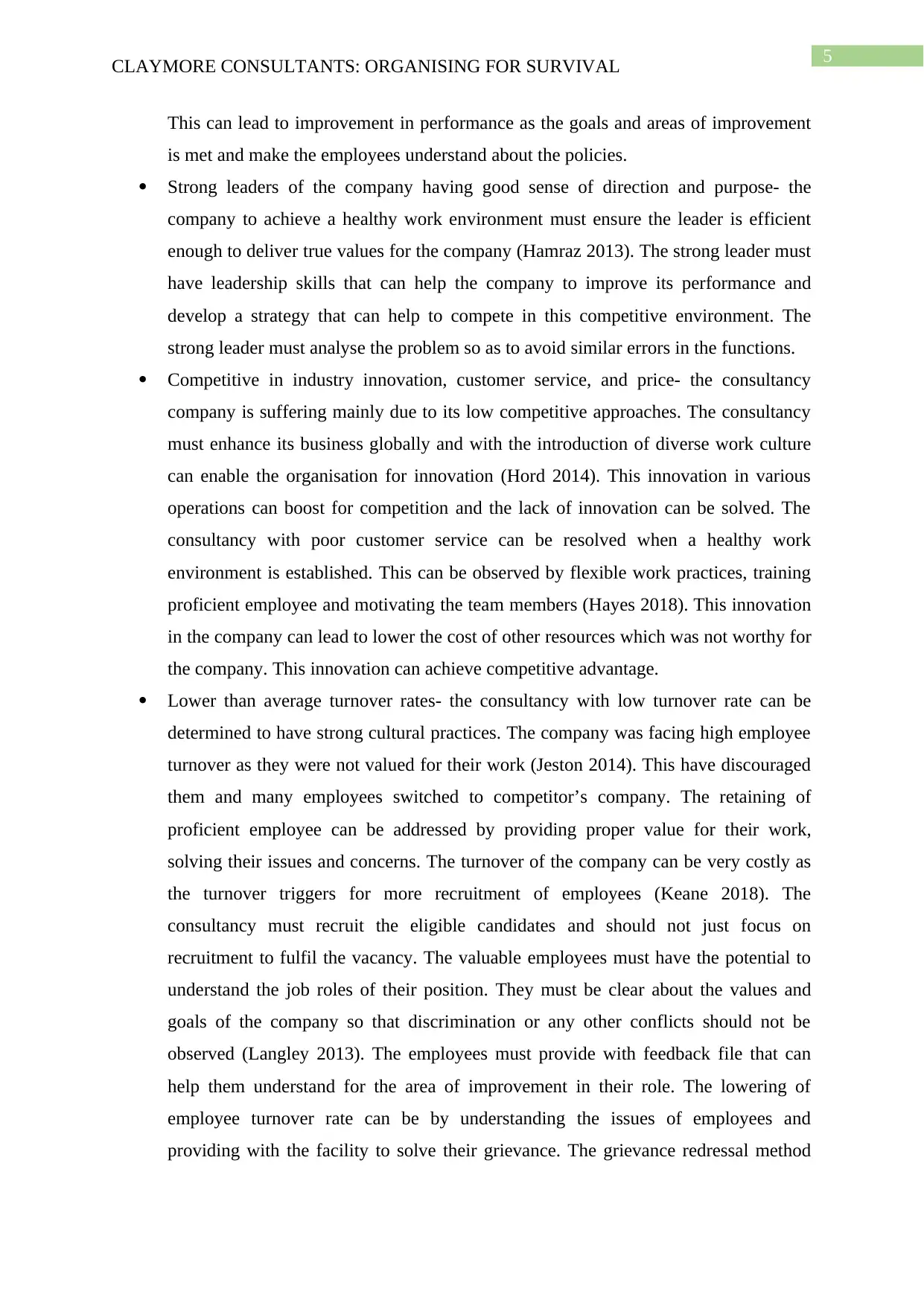
5
CLAYMORE CONSULTANTS: ORGANISING FOR SURVIVAL
This can lead to improvement in performance as the goals and areas of improvement
is met and make the employees understand about the policies.
Strong leaders of the company having good sense of direction and purpose- the
company to achieve a healthy work environment must ensure the leader is efficient
enough to deliver true values for the company (Hamraz 2013). The strong leader must
have leadership skills that can help the company to improve its performance and
develop a strategy that can help to compete in this competitive environment. The
strong leader must analyse the problem so as to avoid similar errors in the functions.
Competitive in industry innovation, customer service, and price- the consultancy
company is suffering mainly due to its low competitive approaches. The consultancy
must enhance its business globally and with the introduction of diverse work culture
can enable the organisation for innovation (Hord 2014). This innovation in various
operations can boost for competition and the lack of innovation can be solved. The
consultancy with poor customer service can be resolved when a healthy work
environment is established. This can be observed by flexible work practices, training
proficient employee and motivating the team members (Hayes 2018). This innovation
in the company can lead to lower the cost of other resources which was not worthy for
the company. This innovation can achieve competitive advantage.
Lower than average turnover rates- the consultancy with low turnover rate can be
determined to have strong cultural practices. The company was facing high employee
turnover as they were not valued for their work (Jeston 2014). This have discouraged
them and many employees switched to competitor’s company. The retaining of
proficient employee can be addressed by providing proper value for their work,
solving their issues and concerns. The turnover of the company can be very costly as
the turnover triggers for more recruitment of employees (Keane 2018). The
consultancy must recruit the eligible candidates and should not just focus on
recruitment to fulfil the vacancy. The valuable employees must have the potential to
understand the job roles of their position. They must be clear about the values and
goals of the company so that discrimination or any other conflicts should not be
observed (Langley 2013). The employees must provide with feedback file that can
help them understand for the area of improvement in their role. The lowering of
employee turnover rate can be by understanding the issues of employees and
providing with the facility to solve their grievance. The grievance redressal method
CLAYMORE CONSULTANTS: ORGANISING FOR SURVIVAL
This can lead to improvement in performance as the goals and areas of improvement
is met and make the employees understand about the policies.
Strong leaders of the company having good sense of direction and purpose- the
company to achieve a healthy work environment must ensure the leader is efficient
enough to deliver true values for the company (Hamraz 2013). The strong leader must
have leadership skills that can help the company to improve its performance and
develop a strategy that can help to compete in this competitive environment. The
strong leader must analyse the problem so as to avoid similar errors in the functions.
Competitive in industry innovation, customer service, and price- the consultancy
company is suffering mainly due to its low competitive approaches. The consultancy
must enhance its business globally and with the introduction of diverse work culture
can enable the organisation for innovation (Hord 2014). This innovation in various
operations can boost for competition and the lack of innovation can be solved. The
consultancy with poor customer service can be resolved when a healthy work
environment is established. This can be observed by flexible work practices, training
proficient employee and motivating the team members (Hayes 2018). This innovation
in the company can lead to lower the cost of other resources which was not worthy for
the company. This innovation can achieve competitive advantage.
Lower than average turnover rates- the consultancy with low turnover rate can be
determined to have strong cultural practices. The company was facing high employee
turnover as they were not valued for their work (Jeston 2014). This have discouraged
them and many employees switched to competitor’s company. The retaining of
proficient employee can be addressed by providing proper value for their work,
solving their issues and concerns. The turnover of the company can be very costly as
the turnover triggers for more recruitment of employees (Keane 2018). The
consultancy must recruit the eligible candidates and should not just focus on
recruitment to fulfil the vacancy. The valuable employees must have the potential to
understand the job roles of their position. They must be clear about the values and
goals of the company so that discrimination or any other conflicts should not be
observed (Langley 2013). The employees must provide with feedback file that can
help them understand for the area of improvement in their role. The lowering of
employee turnover rate can be by understanding the issues of employees and
providing with the facility to solve their grievance. The grievance redressal method
⊘ This is a preview!⊘
Do you want full access?
Subscribe today to unlock all pages.

Trusted by 1+ million students worldwide
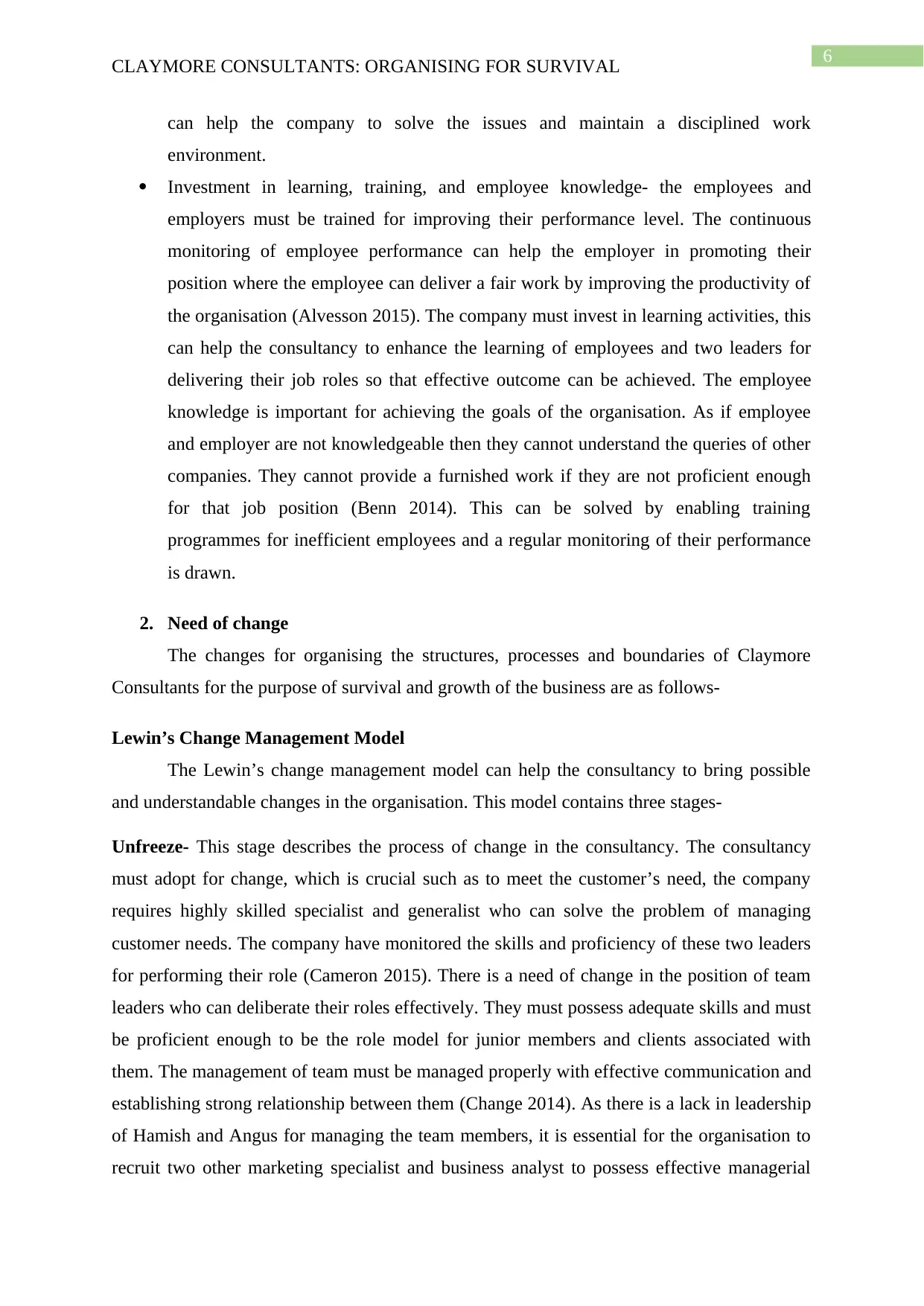
6
CLAYMORE CONSULTANTS: ORGANISING FOR SURVIVAL
can help the company to solve the issues and maintain a disciplined work
environment.
Investment in learning, training, and employee knowledge- the employees and
employers must be trained for improving their performance level. The continuous
monitoring of employee performance can help the employer in promoting their
position where the employee can deliver a fair work by improving the productivity of
the organisation (Alvesson 2015). The company must invest in learning activities, this
can help the consultancy to enhance the learning of employees and two leaders for
delivering their job roles so that effective outcome can be achieved. The employee
knowledge is important for achieving the goals of the organisation. As if employee
and employer are not knowledgeable then they cannot understand the queries of other
companies. They cannot provide a furnished work if they are not proficient enough
for that job position (Benn 2014). This can be solved by enabling training
programmes for inefficient employees and a regular monitoring of their performance
is drawn.
2. Need of change
The changes for organising the structures, processes and boundaries of Claymore
Consultants for the purpose of survival and growth of the business are as follows-
Lewin’s Change Management Model
The Lewin’s change management model can help the consultancy to bring possible
and understandable changes in the organisation. This model contains three stages-
Unfreeze- This stage describes the process of change in the consultancy. The consultancy
must adopt for change, which is crucial such as to meet the customer’s need, the company
requires highly skilled specialist and generalist who can solve the problem of managing
customer needs. The company have monitored the skills and proficiency of these two leaders
for performing their role (Cameron 2015). There is a need of change in the position of team
leaders who can deliberate their roles effectively. They must possess adequate skills and must
be proficient enough to be the role model for junior members and clients associated with
them. The management of team must be managed properly with effective communication and
establishing strong relationship between them (Change 2014). As there is a lack in leadership
of Hamish and Angus for managing the team members, it is essential for the organisation to
recruit two other marketing specialist and business analyst to possess effective managerial
CLAYMORE CONSULTANTS: ORGANISING FOR SURVIVAL
can help the company to solve the issues and maintain a disciplined work
environment.
Investment in learning, training, and employee knowledge- the employees and
employers must be trained for improving their performance level. The continuous
monitoring of employee performance can help the employer in promoting their
position where the employee can deliver a fair work by improving the productivity of
the organisation (Alvesson 2015). The company must invest in learning activities, this
can help the consultancy to enhance the learning of employees and two leaders for
delivering their job roles so that effective outcome can be achieved. The employee
knowledge is important for achieving the goals of the organisation. As if employee
and employer are not knowledgeable then they cannot understand the queries of other
companies. They cannot provide a furnished work if they are not proficient enough
for that job position (Benn 2014). This can be solved by enabling training
programmes for inefficient employees and a regular monitoring of their performance
is drawn.
2. Need of change
The changes for organising the structures, processes and boundaries of Claymore
Consultants for the purpose of survival and growth of the business are as follows-
Lewin’s Change Management Model
The Lewin’s change management model can help the consultancy to bring possible
and understandable changes in the organisation. This model contains three stages-
Unfreeze- This stage describes the process of change in the consultancy. The consultancy
must adopt for change, which is crucial such as to meet the customer’s need, the company
requires highly skilled specialist and generalist who can solve the problem of managing
customer needs. The company have monitored the skills and proficiency of these two leaders
for performing their role (Cameron 2015). There is a need of change in the position of team
leaders who can deliberate their roles effectively. They must possess adequate skills and must
be proficient enough to be the role model for junior members and clients associated with
them. The management of team must be managed properly with effective communication and
establishing strong relationship between them (Change 2014). As there is a lack in leadership
of Hamish and Angus for managing the team members, it is essential for the organisation to
recruit two other marketing specialist and business analyst to possess effective managerial
Paraphrase This Document
Need a fresh take? Get an instant paraphrase of this document with our AI Paraphraser
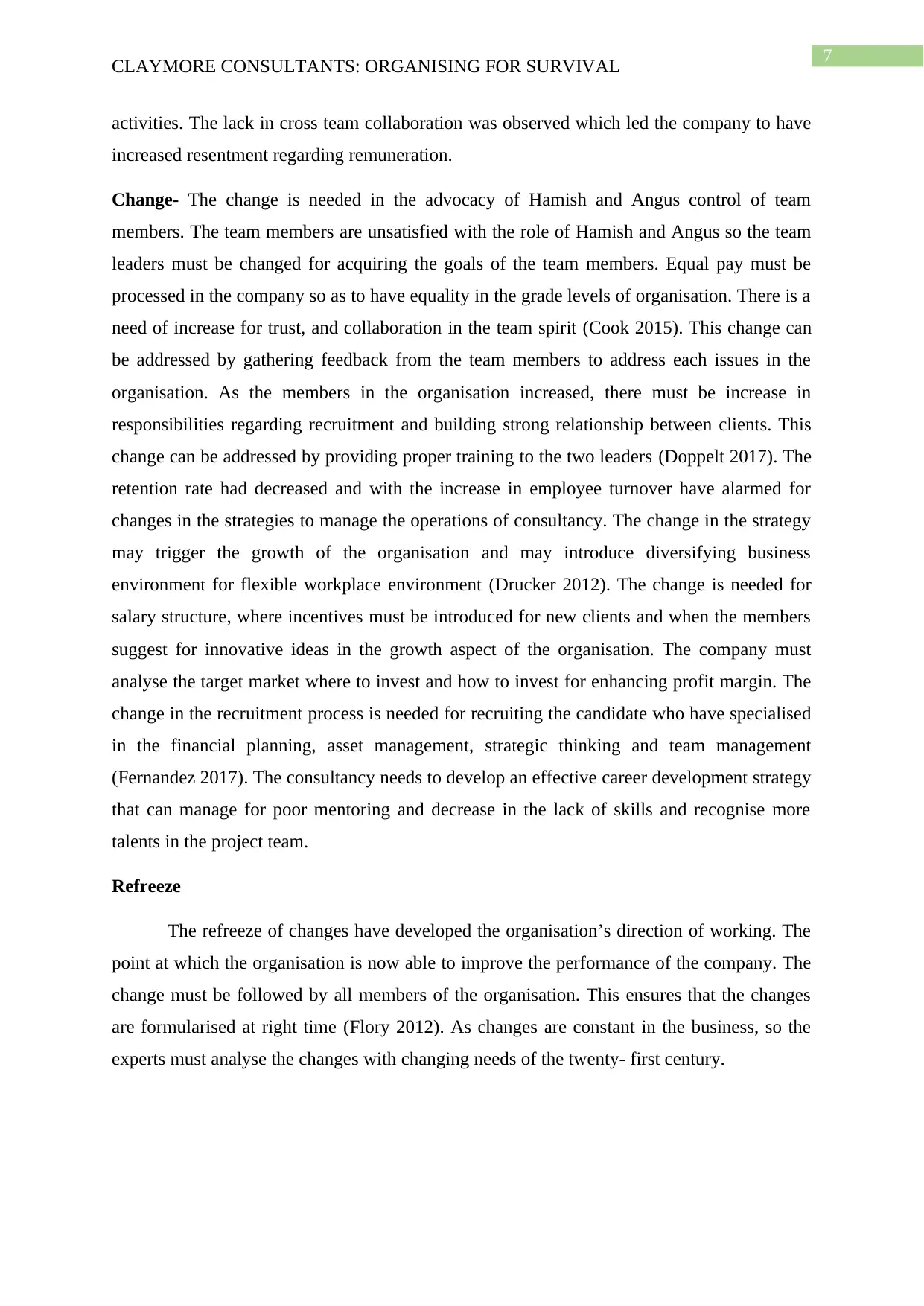
7
CLAYMORE CONSULTANTS: ORGANISING FOR SURVIVAL
activities. The lack in cross team collaboration was observed which led the company to have
increased resentment regarding remuneration.
Change- The change is needed in the advocacy of Hamish and Angus control of team
members. The team members are unsatisfied with the role of Hamish and Angus so the team
leaders must be changed for acquiring the goals of the team members. Equal pay must be
processed in the company so as to have equality in the grade levels of organisation. There is a
need of increase for trust, and collaboration in the team spirit (Cook 2015). This change can
be addressed by gathering feedback from the team members to address each issues in the
organisation. As the members in the organisation increased, there must be increase in
responsibilities regarding recruitment and building strong relationship between clients. This
change can be addressed by providing proper training to the two leaders (Doppelt 2017). The
retention rate had decreased and with the increase in employee turnover have alarmed for
changes in the strategies to manage the operations of consultancy. The change in the strategy
may trigger the growth of the organisation and may introduce diversifying business
environment for flexible workplace environment (Drucker 2012). The change is needed for
salary structure, where incentives must be introduced for new clients and when the members
suggest for innovative ideas in the growth aspect of the organisation. The company must
analyse the target market where to invest and how to invest for enhancing profit margin. The
change in the recruitment process is needed for recruiting the candidate who have specialised
in the financial planning, asset management, strategic thinking and team management
(Fernandez 2017). The consultancy needs to develop an effective career development strategy
that can manage for poor mentoring and decrease in the lack of skills and recognise more
talents in the project team.
Refreeze
The refreeze of changes have developed the organisation’s direction of working. The
point at which the organisation is now able to improve the performance of the company. The
change must be followed by all members of the organisation. This ensures that the changes
are formularised at right time (Flory 2012). As changes are constant in the business, so the
experts must analyse the changes with changing needs of the twenty- first century.
CLAYMORE CONSULTANTS: ORGANISING FOR SURVIVAL
activities. The lack in cross team collaboration was observed which led the company to have
increased resentment regarding remuneration.
Change- The change is needed in the advocacy of Hamish and Angus control of team
members. The team members are unsatisfied with the role of Hamish and Angus so the team
leaders must be changed for acquiring the goals of the team members. Equal pay must be
processed in the company so as to have equality in the grade levels of organisation. There is a
need of increase for trust, and collaboration in the team spirit (Cook 2015). This change can
be addressed by gathering feedback from the team members to address each issues in the
organisation. As the members in the organisation increased, there must be increase in
responsibilities regarding recruitment and building strong relationship between clients. This
change can be addressed by providing proper training to the two leaders (Doppelt 2017). The
retention rate had decreased and with the increase in employee turnover have alarmed for
changes in the strategies to manage the operations of consultancy. The change in the strategy
may trigger the growth of the organisation and may introduce diversifying business
environment for flexible workplace environment (Drucker 2012). The change is needed for
salary structure, where incentives must be introduced for new clients and when the members
suggest for innovative ideas in the growth aspect of the organisation. The company must
analyse the target market where to invest and how to invest for enhancing profit margin. The
change in the recruitment process is needed for recruiting the candidate who have specialised
in the financial planning, asset management, strategic thinking and team management
(Fernandez 2017). The consultancy needs to develop an effective career development strategy
that can manage for poor mentoring and decrease in the lack of skills and recognise more
talents in the project team.
Refreeze
The refreeze of changes have developed the organisation’s direction of working. The
point at which the organisation is now able to improve the performance of the company. The
change must be followed by all members of the organisation. This ensures that the changes
are formularised at right time (Flory 2012). As changes are constant in the business, so the
experts must analyse the changes with changing needs of the twenty- first century.
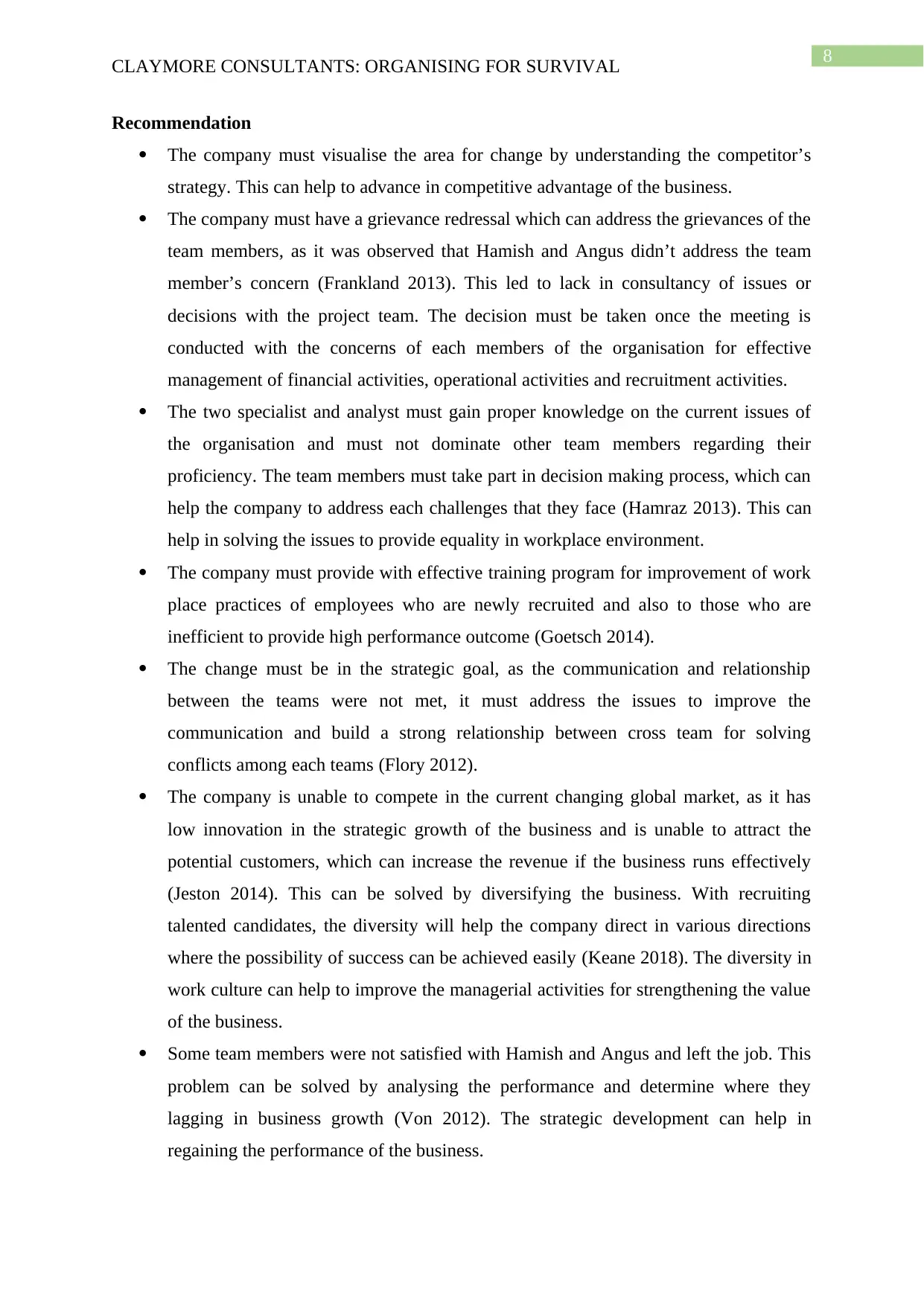
8
CLAYMORE CONSULTANTS: ORGANISING FOR SURVIVAL
Recommendation
The company must visualise the area for change by understanding the competitor’s
strategy. This can help to advance in competitive advantage of the business.
The company must have a grievance redressal which can address the grievances of the
team members, as it was observed that Hamish and Angus didn’t address the team
member’s concern (Frankland 2013). This led to lack in consultancy of issues or
decisions with the project team. The decision must be taken once the meeting is
conducted with the concerns of each members of the organisation for effective
management of financial activities, operational activities and recruitment activities.
The two specialist and analyst must gain proper knowledge on the current issues of
the organisation and must not dominate other team members regarding their
proficiency. The team members must take part in decision making process, which can
help the company to address each challenges that they face (Hamraz 2013). This can
help in solving the issues to provide equality in workplace environment.
The company must provide with effective training program for improvement of work
place practices of employees who are newly recruited and also to those who are
inefficient to provide high performance outcome (Goetsch 2014).
The change must be in the strategic goal, as the communication and relationship
between the teams were not met, it must address the issues to improve the
communication and build a strong relationship between cross team for solving
conflicts among each teams (Flory 2012).
The company is unable to compete in the current changing global market, as it has
low innovation in the strategic growth of the business and is unable to attract the
potential customers, which can increase the revenue if the business runs effectively
(Jeston 2014). This can be solved by diversifying the business. With recruiting
talented candidates, the diversity will help the company direct in various directions
where the possibility of success can be achieved easily (Keane 2018). The diversity in
work culture can help to improve the managerial activities for strengthening the value
of the business.
Some team members were not satisfied with Hamish and Angus and left the job. This
problem can be solved by analysing the performance and determine where they
lagging in business growth (Von 2012). The strategic development can help in
regaining the performance of the business.
CLAYMORE CONSULTANTS: ORGANISING FOR SURVIVAL
Recommendation
The company must visualise the area for change by understanding the competitor’s
strategy. This can help to advance in competitive advantage of the business.
The company must have a grievance redressal which can address the grievances of the
team members, as it was observed that Hamish and Angus didn’t address the team
member’s concern (Frankland 2013). This led to lack in consultancy of issues or
decisions with the project team. The decision must be taken once the meeting is
conducted with the concerns of each members of the organisation for effective
management of financial activities, operational activities and recruitment activities.
The two specialist and analyst must gain proper knowledge on the current issues of
the organisation and must not dominate other team members regarding their
proficiency. The team members must take part in decision making process, which can
help the company to address each challenges that they face (Hamraz 2013). This can
help in solving the issues to provide equality in workplace environment.
The company must provide with effective training program for improvement of work
place practices of employees who are newly recruited and also to those who are
inefficient to provide high performance outcome (Goetsch 2014).
The change must be in the strategic goal, as the communication and relationship
between the teams were not met, it must address the issues to improve the
communication and build a strong relationship between cross team for solving
conflicts among each teams (Flory 2012).
The company is unable to compete in the current changing global market, as it has
low innovation in the strategic growth of the business and is unable to attract the
potential customers, which can increase the revenue if the business runs effectively
(Jeston 2014). This can be solved by diversifying the business. With recruiting
talented candidates, the diversity will help the company direct in various directions
where the possibility of success can be achieved easily (Keane 2018). The diversity in
work culture can help to improve the managerial activities for strengthening the value
of the business.
Some team members were not satisfied with Hamish and Angus and left the job. This
problem can be solved by analysing the performance and determine where they
lagging in business growth (Von 2012). The strategic development can help in
regaining the performance of the business.
⊘ This is a preview!⊘
Do you want full access?
Subscribe today to unlock all pages.

Trusted by 1+ million students worldwide
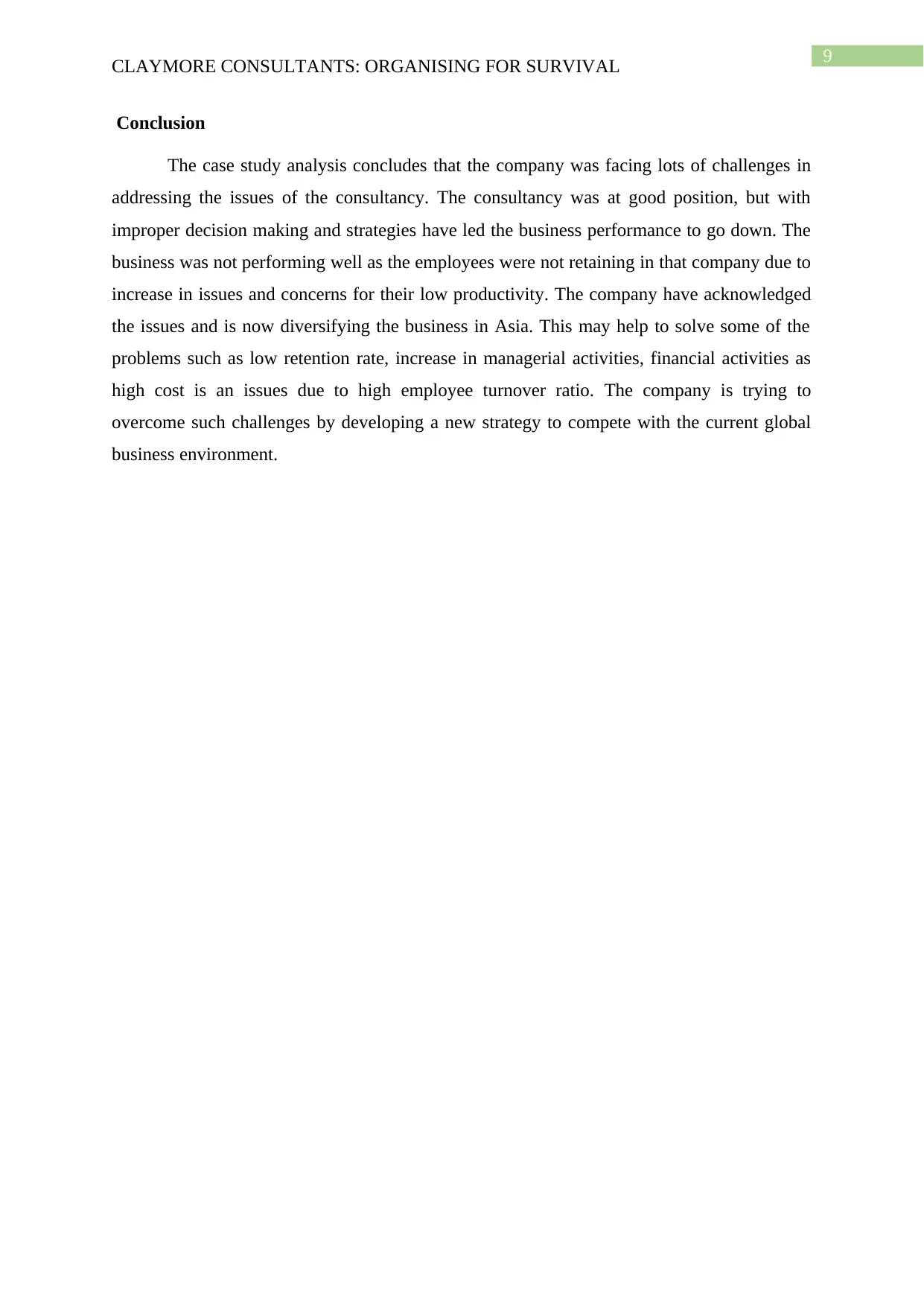
9
CLAYMORE CONSULTANTS: ORGANISING FOR SURVIVAL
Conclusion
The case study analysis concludes that the company was facing lots of challenges in
addressing the issues of the consultancy. The consultancy was at good position, but with
improper decision making and strategies have led the business performance to go down. The
business was not performing well as the employees were not retaining in that company due to
increase in issues and concerns for their low productivity. The company have acknowledged
the issues and is now diversifying the business in Asia. This may help to solve some of the
problems such as low retention rate, increase in managerial activities, financial activities as
high cost is an issues due to high employee turnover ratio. The company is trying to
overcome such challenges by developing a new strategy to compete with the current global
business environment.
CLAYMORE CONSULTANTS: ORGANISING FOR SURVIVAL
Conclusion
The case study analysis concludes that the company was facing lots of challenges in
addressing the issues of the consultancy. The consultancy was at good position, but with
improper decision making and strategies have led the business performance to go down. The
business was not performing well as the employees were not retaining in that company due to
increase in issues and concerns for their low productivity. The company have acknowledged
the issues and is now diversifying the business in Asia. This may help to solve some of the
problems such as low retention rate, increase in managerial activities, financial activities as
high cost is an issues due to high employee turnover ratio. The company is trying to
overcome such challenges by developing a new strategy to compete with the current global
business environment.
Paraphrase This Document
Need a fresh take? Get an instant paraphrase of this document with our AI Paraphraser
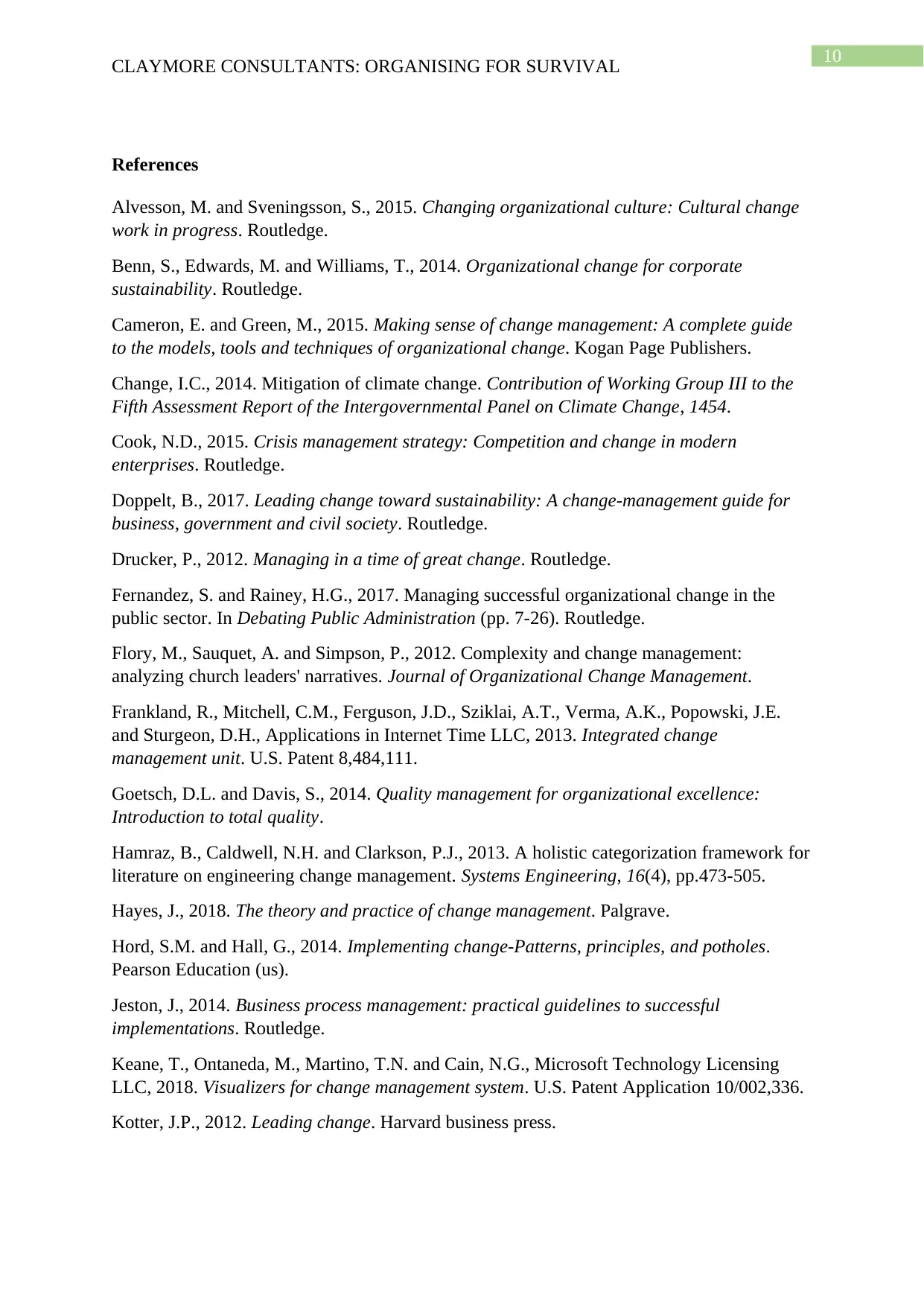
10
CLAYMORE CONSULTANTS: ORGANISING FOR SURVIVAL
References
Alvesson, M. and Sveningsson, S., 2015. Changing organizational culture: Cultural change
work in progress. Routledge.
Benn, S., Edwards, M. and Williams, T., 2014. Organizational change for corporate
sustainability. Routledge.
Cameron, E. and Green, M., 2015. Making sense of change management: A complete guide
to the models, tools and techniques of organizational change. Kogan Page Publishers.
Change, I.C., 2014. Mitigation of climate change. Contribution of Working Group III to the
Fifth Assessment Report of the Intergovernmental Panel on Climate Change, 1454.
Cook, N.D., 2015. Crisis management strategy: Competition and change in modern
enterprises. Routledge.
Doppelt, B., 2017. Leading change toward sustainability: A change-management guide for
business, government and civil society. Routledge.
Drucker, P., 2012. Managing in a time of great change. Routledge.
Fernandez, S. and Rainey, H.G., 2017. Managing successful organizational change in the
public sector. In Debating Public Administration (pp. 7-26). Routledge.
Flory, M., Sauquet, A. and Simpson, P., 2012. Complexity and change management:
analyzing church leaders' narratives. Journal of Organizational Change Management.
Frankland, R., Mitchell, C.M., Ferguson, J.D., Sziklai, A.T., Verma, A.K., Popowski, J.E.
and Sturgeon, D.H., Applications in Internet Time LLC, 2013. Integrated change
management unit. U.S. Patent 8,484,111.
Goetsch, D.L. and Davis, S., 2014. Quality management for organizational excellence:
Introduction to total quality.
Hamraz, B., Caldwell, N.H. and Clarkson, P.J., 2013. A holistic categorization framework for
literature on engineering change management. Systems Engineering, 16(4), pp.473-505.
Hayes, J., 2018. The theory and practice of change management. Palgrave.
Hord, S.M. and Hall, G., 2014. Implementing change-Patterns, principles, and potholes.
Pearson Education (us).
Jeston, J., 2014. Business process management: practical guidelines to successful
implementations. Routledge.
Keane, T., Ontaneda, M., Martino, T.N. and Cain, N.G., Microsoft Technology Licensing
LLC, 2018. Visualizers for change management system. U.S. Patent Application 10/002,336.
Kotter, J.P., 2012. Leading change. Harvard business press.
CLAYMORE CONSULTANTS: ORGANISING FOR SURVIVAL
References
Alvesson, M. and Sveningsson, S., 2015. Changing organizational culture: Cultural change
work in progress. Routledge.
Benn, S., Edwards, M. and Williams, T., 2014. Organizational change for corporate
sustainability. Routledge.
Cameron, E. and Green, M., 2015. Making sense of change management: A complete guide
to the models, tools and techniques of organizational change. Kogan Page Publishers.
Change, I.C., 2014. Mitigation of climate change. Contribution of Working Group III to the
Fifth Assessment Report of the Intergovernmental Panel on Climate Change, 1454.
Cook, N.D., 2015. Crisis management strategy: Competition and change in modern
enterprises. Routledge.
Doppelt, B., 2017. Leading change toward sustainability: A change-management guide for
business, government and civil society. Routledge.
Drucker, P., 2012. Managing in a time of great change. Routledge.
Fernandez, S. and Rainey, H.G., 2017. Managing successful organizational change in the
public sector. In Debating Public Administration (pp. 7-26). Routledge.
Flory, M., Sauquet, A. and Simpson, P., 2012. Complexity and change management:
analyzing church leaders' narratives. Journal of Organizational Change Management.
Frankland, R., Mitchell, C.M., Ferguson, J.D., Sziklai, A.T., Verma, A.K., Popowski, J.E.
and Sturgeon, D.H., Applications in Internet Time LLC, 2013. Integrated change
management unit. U.S. Patent 8,484,111.
Goetsch, D.L. and Davis, S., 2014. Quality management for organizational excellence:
Introduction to total quality.
Hamraz, B., Caldwell, N.H. and Clarkson, P.J., 2013. A holistic categorization framework for
literature on engineering change management. Systems Engineering, 16(4), pp.473-505.
Hayes, J., 2018. The theory and practice of change management. Palgrave.
Hord, S.M. and Hall, G., 2014. Implementing change-Patterns, principles, and potholes.
Pearson Education (us).
Jeston, J., 2014. Business process management: practical guidelines to successful
implementations. Routledge.
Keane, T., Ontaneda, M., Martino, T.N. and Cain, N.G., Microsoft Technology Licensing
LLC, 2018. Visualizers for change management system. U.S. Patent Application 10/002,336.
Kotter, J.P., 2012. Leading change. Harvard business press.
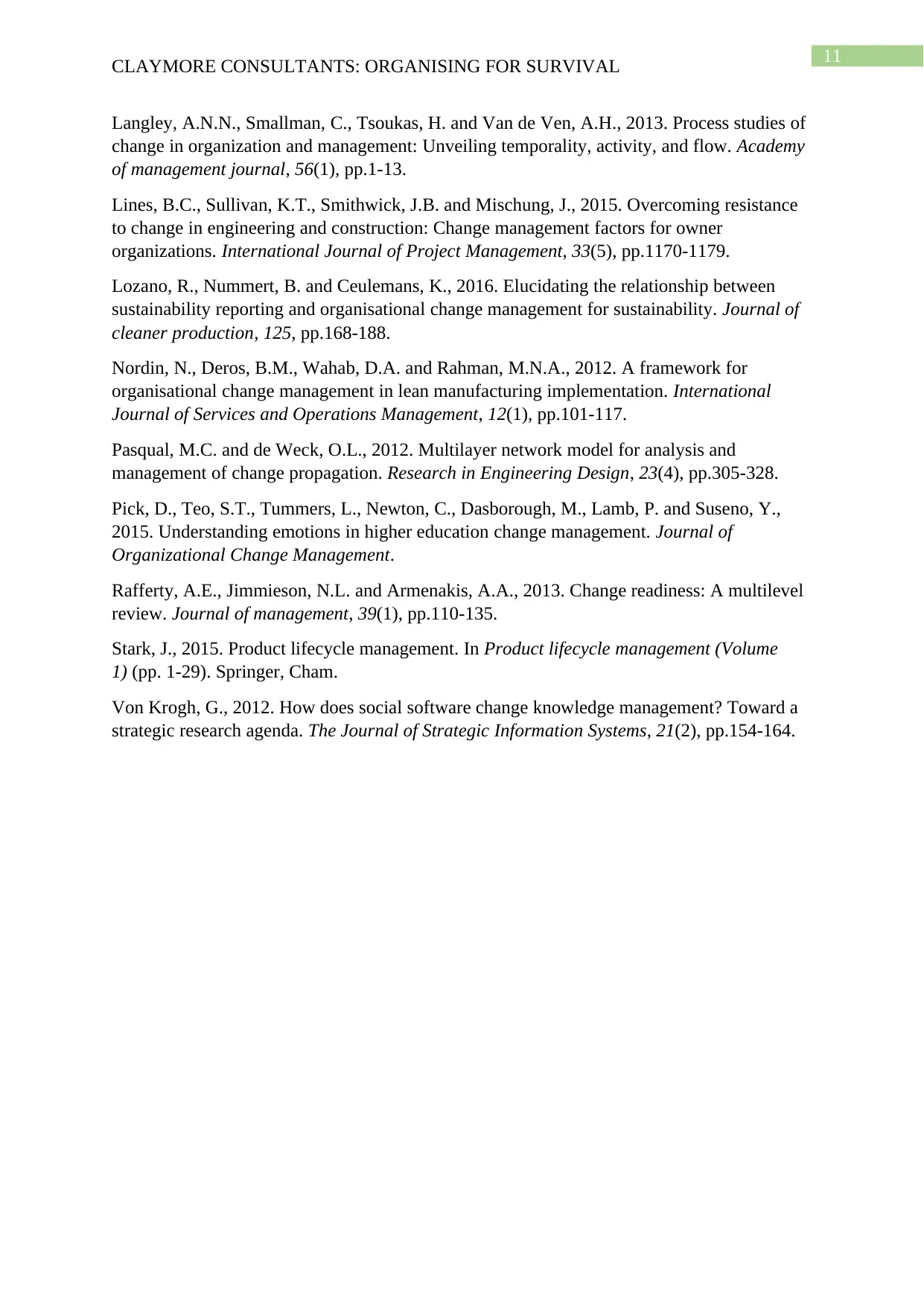
11
CLAYMORE CONSULTANTS: ORGANISING FOR SURVIVAL
Langley, A.N.N., Smallman, C., Tsoukas, H. and Van de Ven, A.H., 2013. Process studies of
change in organization and management: Unveiling temporality, activity, and flow. Academy
of management journal, 56(1), pp.1-13.
Lines, B.C., Sullivan, K.T., Smithwick, J.B. and Mischung, J., 2015. Overcoming resistance
to change in engineering and construction: Change management factors for owner
organizations. International Journal of Project Management, 33(5), pp.1170-1179.
Lozano, R., Nummert, B. and Ceulemans, K., 2016. Elucidating the relationship between
sustainability reporting and organisational change management for sustainability. Journal of
cleaner production, 125, pp.168-188.
Nordin, N., Deros, B.M., Wahab, D.A. and Rahman, M.N.A., 2012. A framework for
organisational change management in lean manufacturing implementation. International
Journal of Services and Operations Management, 12(1), pp.101-117.
Pasqual, M.C. and de Weck, O.L., 2012. Multilayer network model for analysis and
management of change propagation. Research in Engineering Design, 23(4), pp.305-328.
Pick, D., Teo, S.T., Tummers, L., Newton, C., Dasborough, M., Lamb, P. and Suseno, Y.,
2015. Understanding emotions in higher education change management. Journal of
Organizational Change Management.
Rafferty, A.E., Jimmieson, N.L. and Armenakis, A.A., 2013. Change readiness: A multilevel
review. Journal of management, 39(1), pp.110-135.
Stark, J., 2015. Product lifecycle management. In Product lifecycle management (Volume
1) (pp. 1-29). Springer, Cham.
Von Krogh, G., 2012. How does social software change knowledge management? Toward a
strategic research agenda. The Journal of Strategic Information Systems, 21(2), pp.154-164.
CLAYMORE CONSULTANTS: ORGANISING FOR SURVIVAL
Langley, A.N.N., Smallman, C., Tsoukas, H. and Van de Ven, A.H., 2013. Process studies of
change in organization and management: Unveiling temporality, activity, and flow. Academy
of management journal, 56(1), pp.1-13.
Lines, B.C., Sullivan, K.T., Smithwick, J.B. and Mischung, J., 2015. Overcoming resistance
to change in engineering and construction: Change management factors for owner
organizations. International Journal of Project Management, 33(5), pp.1170-1179.
Lozano, R., Nummert, B. and Ceulemans, K., 2016. Elucidating the relationship between
sustainability reporting and organisational change management for sustainability. Journal of
cleaner production, 125, pp.168-188.
Nordin, N., Deros, B.M., Wahab, D.A. and Rahman, M.N.A., 2012. A framework for
organisational change management in lean manufacturing implementation. International
Journal of Services and Operations Management, 12(1), pp.101-117.
Pasqual, M.C. and de Weck, O.L., 2012. Multilayer network model for analysis and
management of change propagation. Research in Engineering Design, 23(4), pp.305-328.
Pick, D., Teo, S.T., Tummers, L., Newton, C., Dasborough, M., Lamb, P. and Suseno, Y.,
2015. Understanding emotions in higher education change management. Journal of
Organizational Change Management.
Rafferty, A.E., Jimmieson, N.L. and Armenakis, A.A., 2013. Change readiness: A multilevel
review. Journal of management, 39(1), pp.110-135.
Stark, J., 2015. Product lifecycle management. In Product lifecycle management (Volume
1) (pp. 1-29). Springer, Cham.
Von Krogh, G., 2012. How does social software change knowledge management? Toward a
strategic research agenda. The Journal of Strategic Information Systems, 21(2), pp.154-164.
⊘ This is a preview!⊘
Do you want full access?
Subscribe today to unlock all pages.

Trusted by 1+ million students worldwide
1 out of 12
Related Documents
Your All-in-One AI-Powered Toolkit for Academic Success.
+13062052269
info@desklib.com
Available 24*7 on WhatsApp / Email
![[object Object]](/_next/static/media/star-bottom.7253800d.svg)
Unlock your academic potential
Copyright © 2020–2025 A2Z Services. All Rights Reserved. Developed and managed by ZUCOL.





